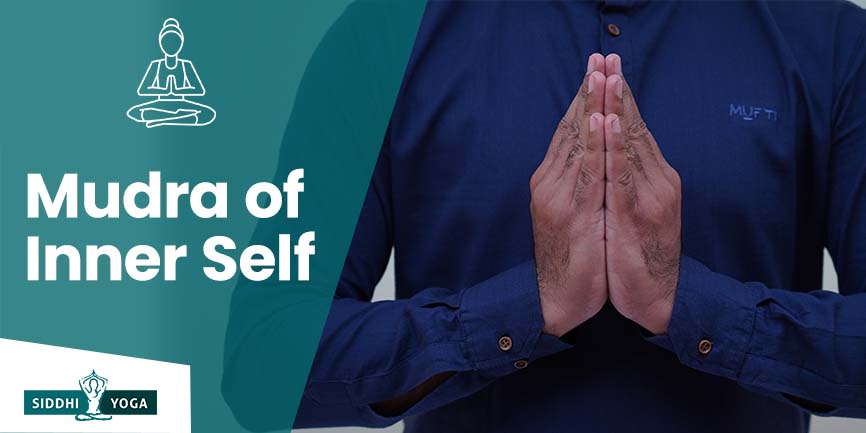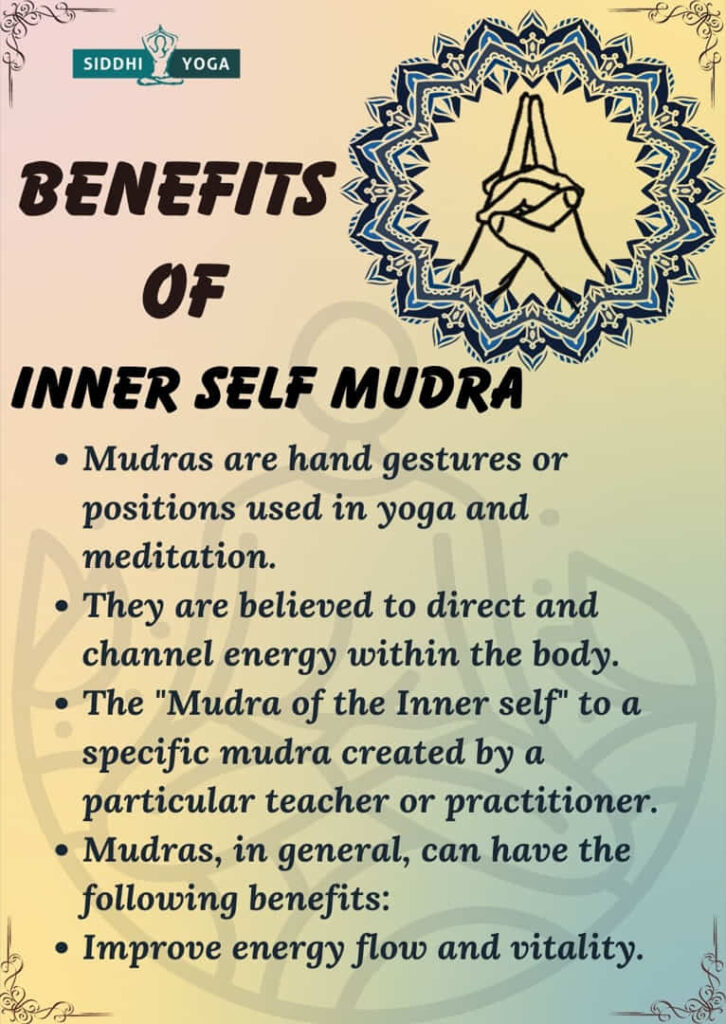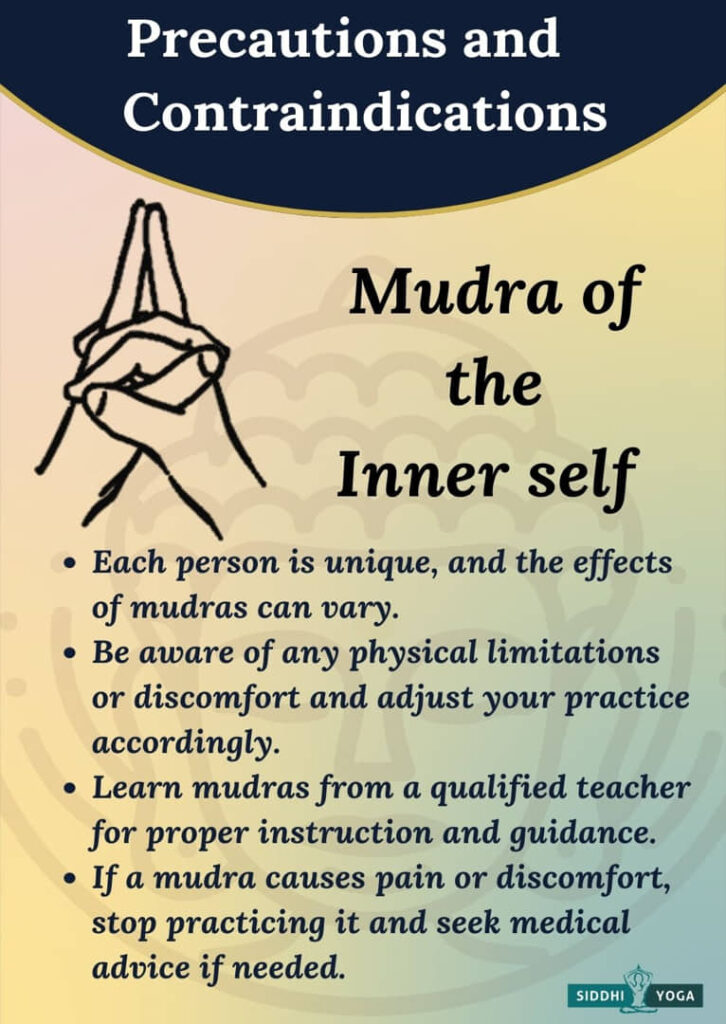
Discover the meaning, benefits, and how to do Mudra of Inner self in this step-by-step guide to get the maximum benefits of this Mudra.
Definition – What is Mudra of the Inner self and its Meaning, References, and Mythology?
Mudra of the Inner self is a type of Hasta Mudra or hand gesture/seal. According to Yogic texts, each individual carries inner energy or power. This power needs to be realized and activated to achieve what you want from your life. Humans have this power within. According to Yogic texts, every human carries a soul. This soul is always connected to the supreme soul. The supreme soul or power has created this world and all living beings. Our inner power is always connected with the supreme power, so we can become whatever we want. We need to concentrate our power on one goal or the things we want in our life. We should not waste our energy and power on the things that deserve no value in our life. Many people tend to put their energy into the things they do not want in their lives, which causes a severe problem as you attract things you do not want. So, after practicing this Mudra, you can keep your energy in the right direction, to a path where you want yourself to be in the next few years of your life. This is one of the reasons why many interviewers and individuals ask where you see yourself in the next five years or ten years because you should be certain about where you are putting your energy.
This Mudra helps to pray without uttering a single word. This Mudra connects your energy to the energy of the divine or the supreme power. So, whatever you pray directly travels to the divine energy.
This Mudra also helps to open up the heart, energy, mind, and soul. Opening the heart symbolizes a more balanced emotional state of mind. Practicing this helps to manage emotions and makes you wiser in your decision makings. It also promotes better and improved learning.
How to Do Mudra of the Inner self?
- This Mudra can be practiced while holding different postures, such as the Child’s Pose if you feel it is right for you to do so.
- However, to gain maximum benefits from this Mudra, you can practice it by sitting in a comfortable meditative posture (Sukhasana, Swastikasana, etc.). Whichever posture you find comfortable while sitting is fine.
- Keep your neck and spine comfortably erect. We do not want any excessive arch in the back.
- Rest both of your palms comfortably on your knee. Palms facing upward towards the sky.
- Gently close your eyes.
- Now, slowly join your palms together in Namaskara or Anjali Mudra.
- Now, gently bring your thumbs close to the inner side of your index fingers. And start to get your thumb close to the first fold of your index fingers. Your thumbs will remain slightly inside while doing so. Your knuckles will move slightly outward. This Mudra is known as the Mudra of the inner self.
- Observe the space behind your eyes known as Chidakash or “Chitta ka Akash.” This dark space also represents the “Akash Tatva” (Space Element).
- Use your imagination to fill Chidakash with white or yellow light.
- Witness your inner self and keep an intention to surrender.
- Inhale and exhale slowly, do not rush to breathe. Take your full time to inhale and exhale.
- You can practice it with different Pranayama and various meditation techniques such as Bhamri Pranayama (Humming Bee Pranayama) & Chandra Bhedi Pranayam (Left Nostril Breathing).
Mudra of the Inner self Benefits

- This helps to surrender everything that is causing pain and stress, whatever is burdening your body and mind.
- This helps to connect with the inner self. Many of us are so busy that we barely get time to understand who we are. We ignore our inner self, which causes problems in the long run. By the time we realize it, the damage has already been done.
- It helps to activate the inner energy, the energy that drives our body. This energy can help to change our future. Utilizing this energy in the right way can help us achieve whatever we want by focusing on the things we want in our life.
- It helps to pray without uttering a word. So, this universe starts to shift itself in accordance with your wishes. It happens, and plenty of stories and books prove it.
Mudra of the Inner self Precautions and Contraindications

Similar to all other Mudra practices, it has no side effects.
However, there are a few things to consider:
- Keep all the fingertips gently pressing each other except your thumbs. All your fingers will remain close to each other but keep some opening between the hands.
- Do not firmly press your finger against each other. They should be slightly touching each other and not put excessive pressure.
- Keep your spine comfortably erect while sitting in any meditative posture.
When and how long to do Mudra of the Inner self?
- If you feel you are doing well but are still not happy. You feel that your inner happiness is not coming to you.
- If you feel that you have something big to achieve in your life and are doing every aspect but still can’t, then you should try it out.
- If you have too many negative thoughts.
Morning is the ideal time to do any yoga or Mudra. In the morning, at this time during the daytime, our brain is at its best. So, you are more likely to be able to concentrate easily. Therefore, you should practice this Mudra from 4 am and 6 am to get the most effective outcomes.
If you are having difficulty with this during the morning, you can do this Mudra later in the evening too.
Do as per the requirements, or four times a day for 15 minutes. Whether you wish to complete it in one stretch or two threes that last between 10 and 15 minutes, it’s up to you. Based on research, the best way to practice an exercise for at least 20 minutes is to get the best benefits of that particular Mudra. This Mudra should be held six times a day for 30 minutes in case of joint aches and pains.
Breathing Mudra of the Inner self
There are two types of breathing we can practice with this Mudra.
- Abdominal Breathing.
- Yogic Breathing (Abdominal Breathing, Thoracic Breathing & Clavicle breathing.)
Visualization Mudra of the Inner self
- Visualize that you are connected to the supreme soul.
- Imagine the supreme soul the way you want it to be.
- The supreme soul will take whichever shape you imagine it to be.
- Just like your dreams, they will become a reality.
Affirmation Mudra of the Inner self
While practicing this, Keep a positive intention. Start with:
“The inner powers within me are unparallel. They will turn from my dreams into reality.”
Conclusion
The Mudra of the Inner self is said to have many benefits, some of which include improving mental and physical health, achieving goals, and manifesting desires. If you’re interested in learning more about Mudras and how to incorporate them into your yoga practice, we offer a comprehensive Mudras Certification Course that covers all 108 Mudras. This course is perfect for both beginners and practitioners.